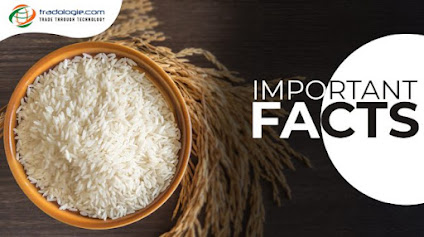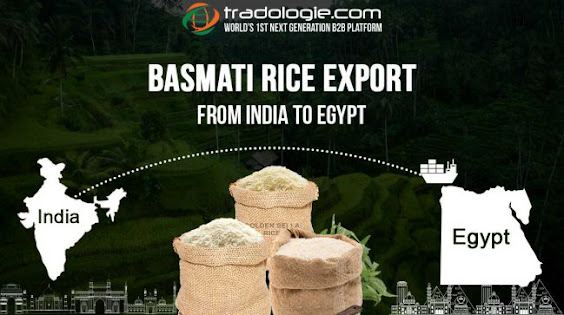What Makes Basmati Rice More Special Than Others? Important Facts
Basmati
Rice is a variety of long, slender-grained aromatic rice, which hails
traditionally from the Indian subcontinent. It is a ‘one-of-a-kind’ specialty rice variety that has been
grown for centuries at the foothills of the Himalayan range.
India meets more
than 70% of the world’s demand for this rice, with Pakistan accounting for the
remainder. India has the widest network of Basmati
Rice exporters.
It’s popular
in Central Asian, Persian, Arab, and other Middle Eastern cuisines. This rare
variety of rice is cultivated in India and supplied to other countries. India
is said to be the global leader in growing the most unique variety of
nutritionally rich, aromatic extra-long grain Basmati rice.
Here is a look at some
interesting and lesser-known facts about Basmati rice that makes it special
from other varieties of rice.
Properties of Basmati Rice:
§ Basmati
rice has been a popular ingredient on the rich and royal menus. It offers a
harmonious blend of fixed kernel sizes, appealing flavor, fluffy rice texture,
high expansion post-cooking, linear elongation of the kernel with minimal
swelling of the width and sweetness, fast digestibility, prolonged shelf life.
§ It is the world’s longest grain rice, both in raw and cooked form, well-known and liked for its delicious taste and irresistible fragrance. It is cautiously grown to preserve its nutritious value.
§ Basmati
Rice is high in nutritious value and can be used in a variety of cuisines. It
is an aromatic delight, widely used in Indian, Mughalai, Continental, and
Chinese cuisines.
§ It
has extra-long slender milled grains, a cooked kernel elongation ratio of 2.5
with a cooked kernel length of up to 22 mm, volume expansion of more than four
times, pleasant aroma, fluffy texture, and easy digestibility.
Health Benefits of Basmati
Rice:
§ The
best thing about this rice is that it is gluten-free and high in vitamins
including niacin and thiamine. Moreover, the rice is fully cholesterol-free,
which greatly contributes to the health and fitness of the human heart, nervous
system, and digestive system.
§ According
to a new study, Basmati rice inhibits the formation of undesirable fat layers
surrounding the arteries as well as the deposition of cholesterol inside them,
lowering the risk of heart disease and vascular illness.
§ It
has a lower GI (glycaemic index) than the majority of other rice varieties. The
GI index is a metric that specifies how easily carbohydrates dissolve in the
body. The slower the GI index, the less blood sugar increases.
§ It is also high in phytic acid and basic polyphenols. It’s an excellent substitute for normal white rice in terms of lowering the risk of Diabetes.
§ Another
health factor is it has high magnesium content which makes Basmati an excellent
choice for a balanced diet.
§ It
contains a lot of fiber, vitamins, and minerals. Rice fiber helps in weight
management, lowering the risk of blood sugar and other ailments in the longer
term.
The Production and Global
Market of Basmati Rice:
§ In
India, it is grown mainly in the northwest Indo-Gangetic region comprising
Punjab, Haryana, Himachal Pradesh, Uttarakhand, Jammu, and Kashmir and 27
western Uttar Pradesh districts.
§ The
agro-climatic conditions of the specific geographical area, as well as the
method of harvesting, processing, and aging, are accountable for the
characteristics of Basmati rice.
§ India
has the distinction of being the world’s leading exporter of Basmati rice. The
annual rice exports from India
are estimated to be between 10 and 13 million MT.
§ India
exported 11.9 million MT of rice in 2018-19 (April-March), with Basmati
accounting for 4.4 million MT and non-basmati accounting for 7.5 million MT.
§ Basmati
rice accounts for 30 percent to 40% of total rice exports, while non-basmati
accounts for 60%. Rice exports account for up to 70% of global exports.
§ Every
year, India exports Basmati to nearly 132 countries around the world. For the
fiscal year 2019-20, India’s basmati rice export recorded approximately 4.55
million tonnes.
§ Iran,
Saudi Arabia, Iraq, United Arab Emirates, and Kuwait are among the most
prominent export destinations.
§ Because
of its higher yield and distinctive grain and cooking efficiency
characteristics, has gained phenomenal acceptance in both the domestic and
global markets, prompting millers to pay farmers a premium price.
§ The
export stat of this Rice has also geared up due to high demand across the
globe, especially in MENA (the Middle East and North Africa).
Tradologie.com
brings you the most convenient route to bulk procurement of Basmati Rice
directly from the manufacturers of India. Importers can buy this aromatic rice
from all the leading exporters and producers enrolled with us. Sellers
registered with us are committed to providing the best basmati rice price and
quality in the market. Producers willing to expand their business globally can
also export
basmati rice through our platform.
Tradologie.com
is the world’s 1st Next-Generation B2B inquiry to delivery trade enabling a
platform facilitating trade of Agro-commodities, raw industrial, and
construction material, across the globe. Over the past four years of operation,
Tradologie.com has been able to develop a network of over 3,25,000 verified
buyers across 65 countries who have successfully transacted trade over 40
billion through tradologie.com with more than 35000 verified manufacturers and
exporters working out of 30 countries. Tradologie.com works by standardizing
buyer requirements and arranging live negotiations with verified sellers
capable of supplying the buyer on the platform on standardized trade policies
which allow for the trade without a phone call or email through the safe
conduit provided by Tradologie.com.
Source Url : https://blog.tradologie.com/what-makes-basmati-rice-more-special-than-others-important-facts/




Comments
Post a Comment